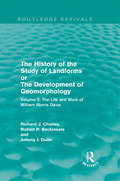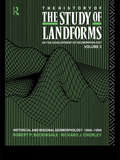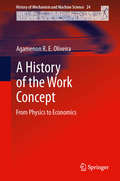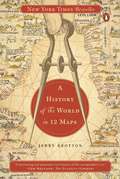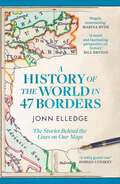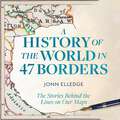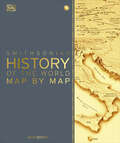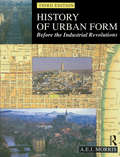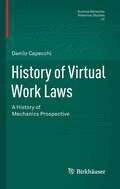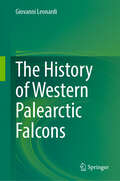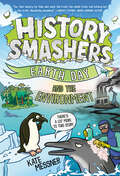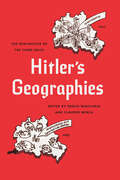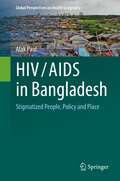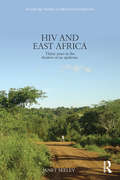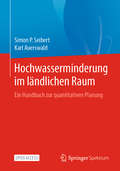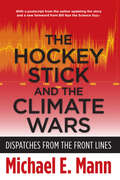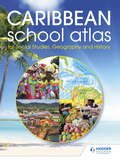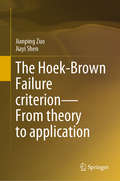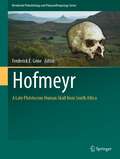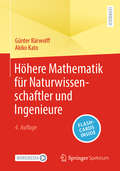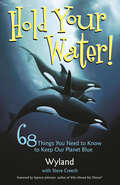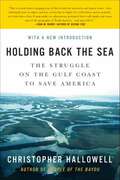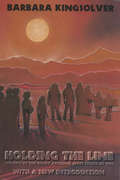- Table View
- List View
The History of the Study of Landforms Volume 2: The Life and Work of William Morris Davis (Routledge Revivals: The History of the Study of Landforms)
by R. P. Beckinsale Mrs R Chorley R. J. Chorley A J Dunn A. J. DunnThis volume is entirely devoted to the life and work of the world's most famous geomorphologist, William Morris Davis (1850-1934). It contains a treatment in depth of Davis' many contributions to the study of landforms including: the cycle of erosion denudation chronology arid and karst geomorphology the coral reef problem.
The History of the Study of Landforms - Volume 3: Historical and Regional Geomorphology, 1890-1950 (Routledge Revivals: The History of the Study of Landforms)
by Robert P. Beckinsale Richard J. ChorleyThis volume provides a global treatment of historical and regional geomorphic work as it developed from the end of the nineteenth century to the hiatus of the Second World War. The book deals with the burgeoning of the eustatic theory, the concepts of isostasy and epeirogeny, and the first complete statements of the cycle of erosion and of polycyclic denudation chronology.
A History of the Work Concept: From Physics to Economics (History of Mechanism and Machine Science #24)
by Agamenon R. E. OliveiraThis book traces the history of the concept of work from its earliest stages and shows that its further formalization leads to equilibrium principle and to the principle of virtual works, and so pointing the way ahead for future research and applications. The idea that something remains constant in a machine operation is very old and has been expressed by many mathematicians and philosophers such as, for instance, Aristotle. Thus, a concept of energy developed. Another important idea in machine operation is Archimedes' lever principle. In modern times the concept of work is analyzed in the context of applied mechanics mainly in Lazare Carnot mechanics and the mechanics of the new generation of polytechnical engineers like Navier, Coriolis and Poncelet. In this context the word "work" is finally adopted. These engineers are also responsible for the incorporation of the concept of work into the discipline of economics when they endeavoured to combine the study of the work of machines and men together.
A History of the World in 12 Maps
by Jerry BrottonA fascinating look at twelve maps-from Ancient Greece to Google Earth-and how they changed our world In this masterful study, historian and cartography expert Jerry Brotton explores a dozen of history’s most influential maps, from stone tablet to vibrant computer screen. Starting with Ptolemy, "father of modern geography,” and ending with satellite cartography, A History of the World in 12 Maps brings maps from classical Greece, Renaissance Europe, and the Islamic and Buddhist worlds to life and reveals their influence on how we-literally-look at our present world. As Brotton shows, the long road to our present geographical reality was rife with controversy, manipulation, and special interests trumping science. Through the centuries maps have been wielded to promote any number of imperial, religious, and economic agendas, and have represented the idiosyncratic and uneasy fusion of science and subjectivity. Brotton also conjures the worlds that produced these notable works of cartography and tells the stories of those who created, used, and misused them for their own ends. .
A History of the World in 47 Borders: The Stories Behind the Lines on Our Maps
by Jonn Elledge'Fascinating and hugely entertaining' MARINA HYDE'By turns surprising, funny, bleak, ridiculous, or all four of those at once' GIDEON DEFOEPeople have been drawing lines on maps for as long as there have been maps to draw on. Sometimes rooted in physical geography, sometimes entirely arbitrary, these lines might often have looked very different if a war or treaty or the decisions of a handful of tired Europeans had gone a different way. By telling the stories of these borders, we can learn a lot about how political identities are shaped, why the world looks the way it does - and about the scale of human folly.From the Roman attempts to define the boundaries of civilisation, to the secret British-French agreement to carve up the Ottoman Empire during the First World War, to the reason why landlocked Bolivia still maintains a navy, this is a fascinating, witty and surprising look at the history of the world told through its borders.
A History of the World in 47 Borders: The Stories Behind the Lines on Our Maps
by Jonn Elledge'Fascinating' TOM HOLLAND | 'A delight from start to finish' MIRANDA SAWYER'By turns surprising, funny, bleak, ridiculous, or all four of those at once' GIDEON DEFOEPeople have been drawing lines on maps for as long as there have been maps to draw on. Sometimes rooted in physical geography, sometimes entirely arbitrary, these lines might often have looked very different if a war or treaty or the decisions of a handful of tired Europeans had gone a different way. By telling the stories of these borders, we can learn a lot about how political identities are shaped, why the world looks the way it does - and about the scale of human folly.From the Roman attempts to define the boundaries of civilisation, to the secret British-French agreement to carve up the Ottoman Empire during the First World War, to the reason why landlocked Bolivia still maintains a navy, this is a fascinating, witty and surprising look at the history of the world told through its borders.More praise for 47 BORDERS: 'Fascinating and hugely entertaining' MARINA HYDE 'You'll never look at a map the same way again' STEPHEN BUSH '[A] clever, confounding history' PATRICK MAGUIRE'A witty grand tour' DORIAN LYNSKEY 'Warm, funny and sharply political' PHIL TINLINE
History of the World Map by Map (DK History Map by Map)
by DKExplore the history of the world in unprecedented detail with this ultimate guide to history throughout the ages. Maps don't just show us where to go, but also where we've been. If you're interested in finding out more about the biggest events in world history, then this book all about history of the world is perfect for you!This stunning history book for adults starts with the evolution and migration of our oldest ancestors out of Africa. You can then look up maps about the Greece and Persian War, the Mongol Conquests, Medieval Europe's trade routes, and the rise of the Ottomans. Explore maps about the colonisation of North America, the scientific revolution, Napoleon's advances, and Britain's control of India. Then uncover the history of later centuries, such as the Age of Imperialism, the American Civil War, industrialised Europe and the transformation of Japan.Journey into past like never before as you uncover:- Easy-to-read text panels for a deeper understanding of history- A total of 140 maps alongside stunning pictures and informative timelines- Storytelling maps to bring history to life- Published in association with the Smithsonian Institution in the USA.Bursting with striking illustrations and full of fascinating detail, this history book is the ultimate gift for map lovers, history enthusiasts of all ages and those who enjoy visiting museums and other historical sites, whether as a present for dad, or handy reference guide for any other history lover in your life! History of the World Map by Map aims to help you gain a strong understanding of some of the forces and movements across continents that have shaped our world!Go on guided tour through time and explore:- Prehistory 7 MYA-3000 BCE- The Ancient World 3000 BCE - 500 CE- Middle Ages 500-1450 CE- The Early Modern World 1450-1700- Revolution and Industry 1700-1850- Progress and Empire 1850-1914- The Modern World 1914-PresentAt DK, we believe in the power of discovery.So why stop there? The Map by Map series includes other titles such as History of the World Map by Map and World War II Map by Map, each detailing historical events and placing them in the context of geography. DK's luxurious Map by Map books are fantastic history gifts, packed with fascinating facts, high-quality photography, and detailed profiles and descriptions of people and events.
History of Urban Form Before the Industrial Revolution
by A.E.J. MorrisProvides an international history of urban development, from its origins to the industrial revolution. This well established book maintains the high standard of information found in the previous two editions, describing the physical results of some 5000 years of urban activity. It explains and develops the concept of 'unplanned' cities that grow organically, in contrast with 'planned' cities that were shaped in response to urban form determinants. Spread throughout the texts are copious illustrations from a wealth of sources, including cartographic urban records, aerial and other photographs, original drawings and the author's numerous analytical line drawings.
History of Virtual Work Laws
by Danilo CapecchiThe book presents a history of classical mechanics by focusing on issues of equilibrium. The historical point of view adopted here restricts attention to cases where the effectiveness of forces is assessed on the basis of the virtual motion of their points of application. For completeness, hints of the alternative approach are also referred, the Archimedean for ancient mechanics and the Newtonian for modern mechanics. The laws resulting from consideration of virtual motions are named laws of virtual work. The modern formulations of the principle of virtual work are only a particular form of them. The book begins with the first documented formulations of laws of virtual work in the IV century BC in Greece and proceeds to the end of the XIX century AD in Europe. A significant space is devoted to Arabic and Latin mechanics of Middle Ages. With the Renaissance it began to appear slightly different wordings of the laws, which were often proposed as unique principles of statics. The process reached its apex with Bernoulli and Lagrange in the XVIII century. The book ends with some chapters dealing with the discussions that took place in the French school on the role of the Lagrangian version of the law of virtual work and its applications to continuum mechanics.
The History of Western Palearctic Falcons
by Giovanni LeonardiFalcons have been exploited by humans as food source, ornamental purposes or for the falconry practices. There is a large historical literature in which falcons were often mentioned but always along broader topics (mainly ancient falconry and poetry). This book is the result of a parallel project developed during the preparation of "Behavioral Ecology of Western Palearctic falcons" (published by Springer in 2020). The main aim is to use archaeological and historical sources on falcons to delineate the past distribution and population ecology of these predators in the Western Palearctic ecozone. Ultimately, the approach to the data is aimed at defining the population dynamics of falcons over time. The relationship/conflict with human populations is also placed in this context. By putting falcons as a central subject of study, this book outlines their path in the Western Palearctic from the Pleistocene to modern ornithology.
History Smashers: Earth Day and the Environment (History Smashers)
by Kate MessnerMyths! Lies! Recycling scams? Discover the real story behind the first Earth Day celebration and some of the biggest US climate catastrophes--and their solutions! Don't miss the award-winning History Smashers series as they get to the truth on the biggest environmental fibs!In April 1970, twenty million people grabbed their rakes, gloves, and recycling bins to celebrate the first Earth Day. Since that environmental kickoff, nature has never been in better shape. RIGHT?WRONG! The real deal is a bit muddier than that. It&’s true that the first Earth Day encouraged people around the globe to clean up their act when it came to the environment. But activists have been working for centuries to save the planet! Native people across the world developed sustainable farming practices, women in eighteenth-century India stood up to protect trees, and amateur scientist Eunice Foote discovered the science behind global warming all the way back in the 1850s!Join the History Smashers team to bust history's biggest misconceptions and figure out what in the world really went down before (and after!) the first Earth Day—and how you can join the fight to protect the environment.Ready to bust new myths? Check out more titles in the History Smashers series: The Mayflower • Plagues & Pandemics • The Titanic • The Underground Railroad • The Salem Witch Trials
Hitler's Geographies: The Spatialities of the Third Reich
by Claudio Minca Paolo GiaccariaLebensraum: the entitlement of "legitimate" Germans to living space. Entfernung: the expulsion of "undesirables" to create empty space for German resettlement. During his thirteen years leading Germany, Hitler developed and made use of a number of powerful geostrategical concepts such as these in order to justify his imperialist expansion, exploitation, and genocide. As his twisted manifestation of spatial theory grew in Nazi ideology, it created a new and violent relationship between people and space in Germany and beyond. With Hitler's Geographies, editors Paolo Giaccaria and Claudio Minca examine the variety of ways in which spatial theory evolved and was translated into real-world action under the Third Reich. They have gathered an outstanding collection by leading scholars, presenting key concepts and figures as well exploring the undeniable link between biopolitical power and spatial expansion and exclusion.
HIV/AIDS in Bangladesh: Stigmatized People, Policy and Place (Global Perspectives on Health Geography)
by Alak PaulThis book aims to show the conditions and behaviors of vulnerable and marginalized people in Bangladesh which put them at risk of HIV/AIDS infection, and what their adopted coping strategies are and how these play out. In addition, the book seeks to gain an understanding of the perceptions of civil society and policy planners with respect to vulnerability to HIV, and the necessary mitigation measures. While there is much published literature on the epidemiology and etiology for the most at-risk groups in the region, there has not yet been any in-depth research concerning the socio-cultural and geographic impacts of HIV issues in Bangladesh. Almost all of the literature shows HIV as an epidemiological problem rather than investigating it from a social or cultural point of view, and still less using qualitative methods. The present work is an endeavor to fill these gaps by providing valuable qualitative field data to demonstrate the causes of HIV risk and vulnerability, and to examine the nature of the social and locational context of HIV/AIDS in Bangladesh and to assist with health care policy planning. The book will be of use to students and researchers, studying public health, health geography, medical sociology, medical anthropology, social psychology and social epidemiology, and to professionals in the fields of development, community medicine, health management and social policy.
HIV and East Africa: Thirty Years in the Shadow of an Epidemic (Routledge Studies in African Development)
by Janet SeeleyBy tracing the shadow of the epidemic over the last 30 years in Uganda and more broadly in the region, HIV and East Africa investigates the impact of the epidemic on people’s lives and livelihoods, placing the epidemic within the context of the social, political and economic changes that have occurred over the last three decades. Whilst it inevitably touches on loss and suffering, the message is also about managing the impact of an epidemic which has had a profound impact on many lives. When one looks for traces in southern Uganda, once thought to be the epicentre of the epidemic, it is hard to see any lasting impact at a community wide level. Delve deeper and there are scars to be found among families and patterns of change which are a direct result of the epidemic The book goes on to explore the effect of improved treatment and care on perceptions of the epidemic and concludes by putting HIV into the context of other disease outbreaks, reflecting on what we can learn from the history of other epidemics as well as the last 30 years of the HIV epidemic.
HMH Science Dimensions™, Earth & Space Science (Hmh Science Dimensions Earth And Space Science Ser.)
by Michael R. Heithaus Michael J. PassowNIMAC-sourced textbook
Hochwasserminderung im ländlichen Raum: Ein Handbuch zur quantitativen Planung
by Simon P. Seibert Karl AuerswaldDiese Open-Access-Publikation ist ein anwendungsorientiertes Lehr- und Handbuch zur Abflussminderung im ländlichen Raum. Meteorologische Extreme wie Dürren, Starkregen und Überschwemmungen häufen sich wegen des Klimawandels. Gleichzeitig steigt der Druck auf unsere Landschaft kontinuierlich, indem sie immer intensiver genutzt und effizienter erschlossen wird. Durch diese Entwicklungen ergeben sich dringende Herausforderungen für den ländlichen Hochwasserschutz und den Erhalt unserer natürlichen Ressourcen Wasser und Boden.Das Buch beschreibt Methoden für die Planung von Maßnahmen zur Abflussminderung. Es ist speziell für kleine Einzugsgebiete ( Die Autoren:Dr. Simon P. Seibert ist Ingenieurökologe und hat über die Entstehung und Modellierung von Hochwasser in München und Karlsruhe promoviert. Seit Mitte 2019 leitet er der Arbeitsgruppe Gebietshydrologie am Bayerischen Landesamt für Umwelt.Prof. Dr. Karl Auerswald lehrt am Wissenschaftszentrum Weihenstephan für Ernährung, Landnutzung und Umwelt der TU München. Seine Forschungsschwerpunkte der vergangenen 40 Jahre sind agrarökologische Prozesse, insbesondere der Wasserhaushalt von Landschaften, Böden, Pflanzen und Tieren.
The Hockey Stick and the Climate Wars: Dispatches from the Front Lines
by Michael MannThe ongoing assault on climate science in the United States has never been more aggressive, more blatant, or more widely publicized than in the case of the Hockey Stick graph—a clear and compelling visual presentation of scientific data, put together by MichaelE. Mann and his colleagues, demonstrating that global temperatures have risen in conjunction with the increase in industrialization and the use of fossil fuels. Here was an easy-to-understand graph that, in a glance, posed a threat to major corporate energy interests and those who do their political bidding. The stakes were simply too high to ignore the Hockey Stick—and so began a relentless attack on a body of science and on the investigators whose work formed its scientific basis.The Hockey Stick achieved prominence in a 2001 UN report on climate change and quickly became a central icon in the "climate wars." The real issue has never been the graph's data but rather its implied threat to those who oppose governmental regulation and other restraints to protect the environment and planet. Mann, lead author of the original paper in which the Hockey Stick first appeared, shares the story of the science and politics behind this controversy. He reveals key figures in the oil and energy industries and the media frontgroups who do their bidding in sometimes slick, sometimes bare-knuckled ways. Mann concludes with the real story of the 2009 "Climategate" scandal, in which climate scientists' emails were hacked. This is essential reading for all who care about our planet's health and our own well-being.
The Hockey Stick and the Climate Wars
by Michael E. MannThe ongoing assault on climate science in the United States has never been more aggressive, more blatant, or more widely publicized than in the case of the Hockey Stick graph-a clear and compelling visual presentation of scientific data, put together by MichaelE. Mann and his colleagues, demonstrating that global temperatures have risen in conjunction with the increase in industrialization and the use of fossil fuels. Here was an easy-to-understand graph that, in a glance, posed a threat to major corporate energy interests and those who do their political bidding. The stakes were simply too high to ignore the Hockey Stick-and so began a relentless attack on a body of science and on the investigators whose work formed its scientific basis.The Hockey Stick achieved prominence in a 2001 UN report on climate change and quickly became a central icon in the "climate wars." The real issue has never been the graph's data but rather its implied threat to those who oppose governmental regulation and other restraints to protect the environment and planet. Mann, lead author of the original paper in which the Hockey Stick first appeared, shares the story of the science and politics behind this controversy. He reveals key figures in the oil and energy industries and the media frontgroups who do their bidding in sometimes slick, sometimes bare-knuckled ways. Mann concludes with the real story of the 2009 "Climategate" scandal, in which climate scientists' emails were hacked. This is essential reading for all who care about our planet's health andour own well-being.
Hodder Education Caribbean School Atlas
by Professor Michael MorrisseyFeel confident in full coverage of the curriculum requirements with an atlas specially created to cover Social Studies, Geography and History. - Encourage awareness of the whole Caribbean region with a 44-page Caribbean section, containing detailed maps of all independent countries and major dependent territories from The Bahamas to Trinidad, and including Belize and Guyana.- Engage students in topical issues with a world mapping section, including features on world climate, the environment and population. - Introduce a solid foundation in geographical knowledge with world facts and figures for all nations.- Secure strong geographical skills with a feature on map reading and how to use an atlas.- Ensure ease-of-use with a 4-page index showing letter-figure grid references to place names found on the maps.
The Hoek-Brown Failure criterion—From theory to application
by Jianping Zuo Jiayi ShenThis book provides a comprehensive coverage of the theory and principle of the Hoek-Brown (HB) failure criterion, methods or guidelines for estimating the HB input parameters, and the methodology of application of the HB criterion in rock engineering projects. It aims to help researchers, engineers and research students who work in the area of rock mechanics and mining engineering. Academics can quickly obtain an overview of the state of the art of the theory and principle of the Hoek-Brown criterion by reading the book before they advance their researches on the topics related to rock failure criteria. Geotechnical engineers can select appropriate Hoek-Brown input parameters for the design and analysis of rock engineering projects with the help of the principles introduced in this book. Research students may use the book as a textbook to learn the principle of rock mechanics related to rock mass properties.
Hofmeyr: A Late Pleistocene Human Skull from South Africa (Vertebrate Paleobiology and Paleoanthropology)
by Frederick E. GrineThis edited volume provides the historical and geological background, as well as the details pertaining to the morphology and morphometric assessments, of a singular human cranial specimen from the Late Pleistocene discovered in Hofmeyr, South Africa. The chapters are divided into 4 main sections. Section 1 discusses the discovery and historical context of the skull, while section 2 addresses its geological and geochronological contexts through dating and stable isotope analyses. Section 3 details the general morphological and morphometric analyses (description, 3-D reconstruction, morphological comparisons), and section 4 details the specific morphological analyses performed (inner ear, dentition, endocranial morphology and size). The volume will be of interest to professional and student paleoanthropologists interested in the later phases of human evolution.
Höhere Mathematik für Naturwissenschaftler und Ingenieure
by Günter Bärwolff Akiko KatoDieses Lehrbuch wendet sich an Studierende der Ingenieur- und Naturwissenschaften und stellt die gesamte Höhere Mathematik, wie sie üblicherweise im Grundstudium behandelt wird, in einem Band zusammen.Ausgangspunkt ist dabei stets die Frage, womit Ingenieure und Naturwissenschaftler in ihrer Arbeit konfrontiert werden, wie z. B. die Modellierung und Optimierung technischer Prozesse oder die Beschreibung physikalischer Gesetzmäßigkeiten. Das Werk erschließt systematisch die zugrunde liegenden mathematischen Themen, ausgehend von der Schulmathematik über die Lineare Algebra bis hin zu partiellen Differenzialgleichungen. Den Autoren gelingt eine in sich geschlossene und didaktisch eingängige Darstellung der Höheren Mathematik, wobei Beweise nur angegeben werden, wenn sie für das Verständnis hilfreich sind. Alle neu eingeführten Begriffe werden durch Abbildungen oder Beispiele veranschaulicht. Eine Vielzahl von Übungsaufgaben (mit Lösungen im Internet)erleichtern die Vertiefung des Lernstoffs.Für die vorliegende 4. Auflage wurde das Werk vollständig durchgesehen und u.a. um das Thema mathematische Grundlagen des Deep Learning ergänzt.Plus: Zudem erhalten Sie Zugang auf ca. 150 Flashcards (Springer-Nature-Flashcards-App), mit denen Sie die Inhalte auf spielerische Weise einüben können.
Hold Your Water: 68 Things You Need to Know to Keep Our Planet Blue
by Wyland Steve CreechHold Your Water offers insight into the water and world around us. Taking a conversational approach to conservation, it dives into simple ways that even little old you can make a difference--all with a witty, and at times whimsical, slant on the world in which we live. The Wyland Foundation is widely lauded by politicians and scientists alike for its practical insight and positive impact on our planet. Former Vice President Al Gore praised the group, saying, "Your organization makes an invaluable contribution to the effort to promote environmental awareness."Hold Your Water is the latest in the organization's legacy of arming everyday people with straight-ahead insight and simple tips for keeping our planet blue. Written by two members of Wyland's staff, the book provides countless fascinating facts about our planet. For instance, did you realize that while two-thirds of the earth's surface is covered by water, only 3 percent of that water is safe to drink? And of that 3 percent, nearly two-thirds is locked up in polar ice caps?The book offers easy ways for people to help preserve water and other related precious resources. Divided into more than 30 sections, this compendium illustrates how everyday activities such as car washing, showering, fertilizing--even 'pet poop' cleanup--can negatively impact the environment. It then delivers more than 100 tips and tidbits that will help you protect your planet.Whether you are one of the nearly three-quarters of Americans who consider themselves environmentalists, or you just want to know more about the world in which you live, Hold Your Water is a book worth holding on to.
Holding Back the Sea: The Struggle on the Gulf Coast to Save America
by Christopher HallowellKatrina's arrival on the Gulf Coast was a long time in coming. But it was assured. Since 1965, when Hurricane Betsy struck New Orleans, breached a levee, and flooded part of the city, everyone was waiting and talking about when the Big One would strike and do even more damage. Katrina was that hurricane, predictedand imagined before she struck, but so much worse in her reality.Holding Back the Sea is about the consequences of ignoring the warning signs that nature provides and the struggle to convince the rest of the country that South Louisiana lay in the path of destruction. The signs were not subtle; there were Hurricanes Andrew in 1992, George and Mitch in 1998, and Ivan in 2004, among others. At one time or another in their journeys north, they all threatened New Orleans. Some had headed right for the city before veering to the east and west, sparing the Big Easy and reinforcing the nickname. But the Big Easy ended -- at least in reputation -- on August 29, 2005, when the Big One came ashore as Katrina.
Holding the Line: Women in the Great Arizona Mine Strike of 1983
by Barbara KingsolverHolding the Line, Barbara Kingsolver's first non-fiction book, is the story of women's lives transformed by an a signal event. Set in the small mining towns of Arizona, it is part oral history and part social criticism, exploring the process of empowerment which occurs when people work together as a community. Like Kingsolver's award-winning novels, Holding the Line is a beautifully written book grounded on the strength of its characters. Hundreds of families held the line in the 1983 strike against Phelps Dodge Copper in Arizona. After more than a year the strikers lost their union certification, but the battle permanently altered the social order in these small, predominantly Hispanic mining towns. At the time the strike began, many women said they couldn't leave the house without their husband's permission. Yet, when injunctions barred union men from picketing, their wives and daughters turned out for the daily picket lines. When the strike dragged on and men left to seek jobs elsewhere, women continued to picket, organize support, and defend their rights even when the towns were occupied by the National Guard. "Nothing can ever be the same as it was before," said Diane McCormick of the Morenci Miners Women's Auxiliary. "Look at us. At the beginning of this strike, we were just a bunch of ladies. "
